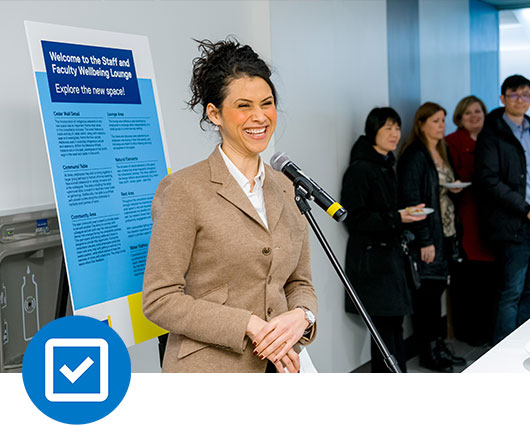Workplace Safety and Insurance (WSIB) Performance

test
Ryerson’s goal continues to be to eliminate injuries on campus completely. We move towards this goal by creating a safe and healthy work, learning and research environment that contributes to our community’s wellbeing.
Overall, this past year saw significant reduction in days lost.

Comparing WSIB performance from 2015 to 2018
This chart compares Ryersons WSIB performance from 2015-2018 for critical injuries, days lost, lost time injuries, severity rate and performance index.
From 2017 to 2018 all WSIB metrics decreased, except for critical injuries. Additional information about the all five metrics in this chart are provided in subsequent information on this page.
WSIB costs
These numbers reflect Ryerson’s WSIB costs, based on a September 2017 New Experimental Experience Rating (NEER) statement. NEER is the experience rating program for non-construction employers with annual premiums over $25,000. In 2018, Ryerson’s annual premiums were around $1.4M.
The NEER program compares the employer’s actual claim costs over a four-year period to the expected costs compared to similar organizations. If the actual claim costs are lower than expected, the employer is eligible for a rebate; if higher, the employer receives a surcharge. Ryerson’s 2018 NEER Cost was $345K (this cost reflects what WSIB would pay out to injured employees including total benefits paid, future projected costs and an administrative cost).
Our NEER cost was lower than other similar organizations. Consequently, the university received almost $40K in rebates 2018.
$1.359M
Premium
$39.9k
Rebates

Understanding WSIB performance statistics
Critical injuries
Critical injuries are defined by the Ontario Occupational Health and Safety Act (external link) , and must be reported to the Ontario Ministry of Labour.
In 2018 there were eight critical injuries on campus. Four injuries included employees, three involved students and one injury involved a visitor to Ryerson.

Employee critical injuries
- Fall while moving a table (Fracture)
- Tripped on a rock used to prop open a door (Fracture)
- Grill in the cafeteria (Burn)
- Slipped on wet leaves outside (Fracture)
Student critical injuries
- Pinch injury while working on a wrench (Unconsciousness)
- Unconsciousness (pre-existing medical condition)
- Unconsciousness (pre-existing medical condition)
Visitor critical injury
- Unconsciousness (pre-existing medical condition)

Days lost
Days lost indicate the number of days an employee was away from work recuperating from a work-related injury.
One case accounted for 40% of the days lost due to an unknown object that flew into the eye of the worker when the worker was outside the building on their way to work.

In 2018, we saw a steep reduction in the number of days lost from 404 to 227. This represents a 44% reduction.

Lost time injuries (LTIs)
Lost time injuries lead to time away from work because of the injury. In 2018, there were 18 lost time injuries. This is the lowest that Ryerson has documented in the last three years, and a 14% reduction from 2017.

Causes of LTIs
7
Slips, trips and falls
4
Struck or caught by
3
Overexertion
4
Other
Lost time injuries frequency
This chart compares Ryerson's Lost Time Frequency rate with other organizations in our rate groups from 2013 to 2018. The rate group includes universities, libraries and museums, etc.
From 2013 - 2015 Ryerson had a much lower injury rate that other similar orgaizations. In 2016, we were higher (0.33 compared 0.3 for our rate group), and in 2017 and 2018, we are once again lower than our rate group average.

Severity rate
Severity Rate calculates the average number of days lost per injury within a given year. It is calculated by dividing year-to-date days lost, regardless of accident dates, divided by the full time equivalent worker multiplied by 100.
In 2018, our severity rate reduces from 6.88 in 2017 to 3.68. This reflects a 47% reduction.


Performance index
The performance index (PI) compares the firm’s (i.e. Ryerson University's) actual injury cost and the expected costs. A PI greater than one indicates a surcharge and PI less than one indicates a rebate.
In 2017, for the first time in Ryerson’s reporting history the university scored a surcharge PI. In 2018, the university saw a steep drop in our PI to 0.96 and we are once again in a rebate position. In 2018, Ryerson received almost $40K in rebates.


What’s next for health protection in 2019

Increased awareness of incident reporting requirements at the management and supervisor levels throughout the academic and non-academic areas. How will we do this? Through new face-to-face training module for managers and supervisors.

Promote reporting of near misses in high risk areas. Research has shown that for every injury that occured, a series of preventable factors or events immediately preceded it. It is often the case that if a near miss had been identified and addressed in advance, it could have led to a less severe outcome. Early recognition and reporting helps to prevent future occurrences and helps to ensure the safe return to work for those involved.

Human Resources’ Workplace Wellbeing Services has partnered with Safety First to strengthen the return-to-work program and to further reduce time away from work. Workplace Wellbeing Services will introduce a formal modified duties program in 2019.